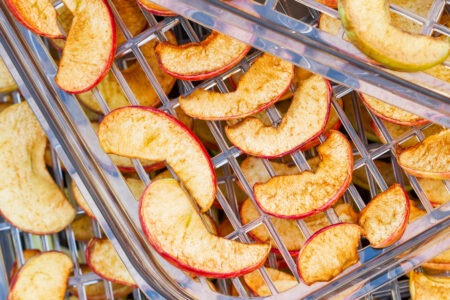
Content Menu
● Types of Food Dehydrators
● Key Features to Consider
● Capacity
● Energy Efficiency
● Cleaning and Maintenance
>> How to Clean Your Dehydrator
● Safety Features
● Price Range
● Benefits of Using a Food Dehydrator
● Common Foods to Dehydrate
● Dehydration Process Overview
● Tips for Successful Dehydration
● Conclusion
● FAQ
>> 1. What is the best temperature for dehydrating food?
>> 2. How long does it take to dehydrate fruits?
>> 3. Can I dehydrate vegetables?
>> 4. Do I need to rotate trays during dehydration?
>> 5. Is it safe to dehydrate meat?
● Citations:
Food dehydrators have become increasingly popular among home cooks and health enthusiasts alike. They allow for the preservation of fruits, vegetables, meats, and herbs by removing moisture, which can help extend shelf life and maintain nutritional value. If you're considering investing in a food dehydrator, there are several key features and factors to keep in mind to ensure you choose the right one for your needs.

Types of Food Dehydrators
Food dehydrators generally fall into two main categories:
- Stackable Dehydrators: These typically have round trays that stack on top of each other. The heating element and fan can be located at the top or bottom. While stackable models are often more compact and affordable, they may require periodic tray rotation for even drying.
- Box-style Dehydrators: These units feature slide-in trays similar to an oven. The fan and heating elements are usually positioned at the back, which allows for more consistent airflow and reduces the need for tray rotation.
Key Features to Consider
When selecting a food dehydrator, consider the following features:
- Adjustable Temperature Control: Different foods require different temperatures for optimal dehydration. Look for a model with adjustable temperature settings, typically ranging from 90°F to 160°F.
- Timer Functionality: A timer allows you to set the dehydrator and forget about it until it's done. This is especially useful if you plan to dehydrate foods overnight or while at work.
- Number of Trays: The number of trays affects how much food you can dehydrate at once. More trays mean more capacity but also require space for storage.
- Tray Material: Trays can be made from plastic or stainless steel. Stainless steel is more durable and easier to clean but usually comes at a higher price point.
- Noise Level: Some dehydrators can be quite noisy. If noise is a concern, look for models that operate quietly.
- Air Filters: High-quality dehydrators may come with air filters that prevent dust and other particles from contaminating your food.
Capacity
The capacity of a dehydrator is crucial depending on your needs:
- For occasional use or small batches, a smaller model may suffice.
- If you plan to dehydrate large quantities (for example, preserving harvests), consider a larger unit with multiple trays.
Energy Efficiency
Look for energy-efficient models that consume less power while still providing effective dehydration capabilities. This is particularly important if you plan to use the dehydrator frequently.
Cleaning and Maintenance
Ease of cleaning is an important factor. Removable trays that are dishwasher safe can save time and effort in maintaining your dehydrator. Regular cleaning helps prevent cross-contamination between different foods and ensures the longevity of your appliance.
How to Clean Your Dehydrator
1. Disassemble: Remove all trays, mesh liners, and any other removable parts.
2. Vacuum: Use a vacuum cleaner to remove any loose debris from the interior.
3. Wipe Down: Use a damp cloth with antibacterial spray to wipe down both the interior and exterior surfaces.
4. Wash Removable Parts: Wash trays in warm soapy water or place them in the dishwasher.
5. Dry All Parts: Ensure all parts are completely dry before reassembling to avoid mold growth[1][4][12].
Safety Features
Some dehydrators come equipped with safety features such as automatic shut-off functions that prevent overheating or burning food.
Price Range
Food dehydrators vary significantly in price. Budget models may start around $50, while high-end units can exceed $300. Determine your budget beforehand and weigh it against the features you require.

Benefits of Using a Food Dehydrator
Using a food dehydrator offers numerous advantages:
- Extended Shelf Life: Dehydrating food removes moisture that promotes spoilage, allowing items like fruits and vegetables to last longer without preservatives.
- Nutritional Retention: Unlike cooking methods that expose food to high heat for extended periods, dehydration preserves vitamins and minerals effectively[9][10].
- Cost Savings: By purchasing seasonal produce in bulk and preserving it through dehydration, you can save money over time while reducing food waste[19][24].
- Healthy Snacking Options: Homemade dried fruits or jerky can serve as nutritious snacks without added sugars or preservatives found in many store-bought options[6][9].
Common Foods to Dehydrate
You can use a dehydrator for various foods:
- Fruits: Apples, bananas, strawberries, mangoes
- Vegetables: Tomatoes, peppers, carrots
- Herbs: Basil, thyme, parsley
- Meats: Beef jerky, chicken strips
- Grains & Legumes: Cooked rice or beans[7][10][24].
Dehydration Process Overview
The dehydration process involves several steps:
1. Preparation: Clean and slice your food into uniform pieces to ensure even drying.
2. Pretreatment (if necessary): Some fruits may benefit from pretreatment with lemon juice or ascorbic acid to prevent browning.
3. Placement on Trays: Lay out food evenly on trays without overlapping.
4. Setting Temperature & Time: Adjust settings based on the type of food being dried[15][25].
5. Monitoring Progress: Check periodically for doneness; most fruits should feel leathery but not sticky when done.
6. Conditioning (optional): After drying, let dried foods cool before storing them in airtight containers; this helps equalize moisture levels[5][12].
Tips for Successful Dehydration
- Cut foods into uniform sizes for consistent drying.
- Avoid overcrowding trays; good air circulation is essential.
- Store dried foods in cool, dark places in airtight containers to maximize shelf life[19][24].
Conclusion
Choosing the right food dehydrator involves understanding your specific needs and preferences. Whether you're looking to make healthy snacks, preserve seasonal produce, or create homemade jerky, paying attention to these key features will help you select a model that meets your expectations.
Investing in a quality food dehydrator not only enhances your culinary skills but also contributes to sustainable living by reducing food waste.

FAQ
1. What is the best temperature for dehydrating food?
The most commonly recommended temperature for dehydrating foods is around 140°F (60°C). However, different foods may require different temperatures; herbs typically need 90°F (32°C), while meats should be dried at 145°F (63°C) to ensure safety.
2. How long does it take to dehydrate fruits?
Dehydration times vary based on the type of fruit and thickness of slices. Generally, fruits like apples may take anywhere from 6 to 12 hours at 140°F (60°C) depending on moisture content.
3. Can I dehydrate vegetables?
Yes! Most vegetables can be successfully dehydrated. Common choices include tomatoes, peppers, onions, and carrots. Make sure to blanch them first if necessary.
4. Do I need to rotate trays during dehydration?
In stackable models, it's often recommended to rotate trays periodically for even drying since some trays may dry faster than others due to their proximity to the heating element.
5. Is it safe to dehydrate meat?
Yes, but it's crucial to ensure that meat is dried at appropriate temperatures (at least 145°F or 63°C) to eliminate harmful bacteria.
Citations:
[1] https://www.webstaurantstore.com/guide/741/food-dehydrators-buying-guide.html
[2] https://www.youtube.com/watch?v=lEUA2t2XD5M
[3] https://www.callmelore.com/fool-proof-healthy-dehydrator-recipes/
[4] https://www.wisdompreserved.life/how-to-clean-a-dehydrator
[5] https://www.youtube.com/watch?v=p5h2YQOwpfU
[6] https://www.bestbuy.com/discover-learn/10-reasons-to-buy-a-food-dehydrator/pcmcat1634332391134
[7] https://www.freshoffthegrid.com/dehydrating-food/
[8] https://www.commercialdehydrators.com.au/dehydrating-recipes-filters
[9] https://www.webmd.com/diet/dehydrating-food-good-for-you
[10] https://homesteadingfamily.com/preservation-101-intro-to-dehydrating-food/
[11] https://www.youtube.com/watch?v=rXNIHzcE8F0
[12] https://www.backcountrypaleo.com/cleaning-food-dehydrator/
[13] https://www.goodhousekeeping.com/cooking-tools/g30200878/best-food-dehydrator/
[14] https://www.goodhousekeeping.com/appliances/a31904157/what-is-a-dehydrator/
[15] https://learn.eartheasy.com/guides/a-beginners-guide-to-dehydrating-food/
[16] https://eatsleepwild.com/homemade-dehydrated-backpacking-meals/
[17] https://seedtopantryschool.com/quick-tips-on-how-to-clean-your-dehydrator/
[18] https://www.thespruceeats.com/best-food-dehydrators-4077285
[19] https://brodandtaylor.com/pages/dehydrating
[20] https://www.breville.com/content/breville/us/en/blog/cooking/how-to-use-a-dehydrator/_jcr_content/root/container_741553154/container/image.coreimg.85.1200.jpeg/1718622778417/how-to-use-dehydrator.jpeg?sa=X&ved=2ahUKEwikne_d3eqKAxXKke4BHcVgHf8Q_B16BAgFEAI
[21] https://www.backpackingchef.com/food-dehydrator-recipes.html
[22] https://farmerswiferambles.com/care-for-your-food-dehydrator/
[23] https://www.reddit.com/r/dehydrating/comments/1grd7r2/im_searching_for_the_best_food_dehydrator_of_2025/
[24] https://www.healthline.com/nutrition/dehydrated-food
[25] https://www.allrecipes.com/article/how-to-use-a-food-dehydrator/
[26] https://insanelygoodrecipes.com/dehydrator-recipes/
[27] https://images.thdstatic.com/catalog/pdfImages/80/807ed785-917a-4de7-9120-2adf8c7d405a.pdf
[28] https://www.allrecipes.com/thmb/IBOoLhB5IFlt9pVQ4R3Yo2vHXW4=/1500x0/filters:no_upscale():max_bytes(150000):strip_icc()/Testing_NescoFD-1040GardenmasterDigitalProFoodDehydratorforJerkyandSnacksWhite_148-e21e53645bf3480295e37ab0a7c733db.jpeg?sa=X&ved=2ahUKEwj2psKh4uqKAxUJhIkEHRs8DEEQ_B16BAgGEAI
[29] https://www.mitchellcooper.co.uk/10-alternative-uses-for-dehydrators
[30] https://www.foodandwine.com/lifestyle/12-brilliant-ways-use-dehydrator
[31] https://www.reddit.com/r/dehydrating/comments/lkjdl8/im_new_how_do_i_clean_my_dehydrator_after/
[32] https://www.foodandwine.com/lifestyle/kitchen/best-food-dehydrators
[33] https://community.waring.com/blog/p/13or1/the-remarkable-benefits-of-adding-a-food-dehydrator-to-your-kitchen-arsenal
[34] https://nouveauraw.com/reference-library/dehydrator-basics/how-to-clean-and-care-for-your-dehydrator/
[35] https://www.nytimes.com/wirecutter/reviews/best-food-dehydrator/
[36] https://www.thepurposefulpantry.com/easy-tips-to-clean-your-dehydrator/
[37] https://septree.com/pages/how-do-i-clean-my-home-food-dryer
[38] https://www.youtube.com/watch?v=1QOiMXwza90











